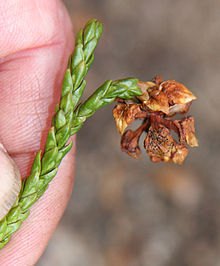Athrotaxis laxifolia
| Athrotaxis laxifolia | |
|---|---|

| |
| Scientific classification | |
| Kingdom: | Plantae |
| Clade: | Tracheophytes |
| (unranked): | Gymnosperms |
| Division: | Pinophyta |
| Class: | Pinopsida |
| Order: | Pinales |
| Family: | Cupressaceae |
| Genus: | Athrotaxis |
| Species: | A. laxifolia
|
| Binomial name | |
| Athrotaxis laxifolia | |

Description[]
Athrotaxis laxifolia is an evergreen coniferous tree growing to 12–21 m tall with a conical, sparsely branched crown[2] and a trunk up to 1m diameter. It is commonly known as the Summit or Yellow-Twig athrotaxis.[2] The leaves are scale-like, 4–12 mm long and 2–3 mm broad, arranged spirally on the shoots. The seed cones are oblong-globose, 15–26 mm long and 14–20 mm diameter, with 14–18 spirally-arranged scales; they are mature about six months after pollination. The pollen cones are 3–5 mm long.[3] The bark of A. laxifolia is dark orange-brown, deeply fissured and flaky.[2] The species name laxifolia refers to the wider spacing of the leaves as compared with the other conifers in it's genus, Athrotaxis cuppressoides and Athrotaxis selaginoides.[2]
Habitat & Distribution[]
Athrotaxis laxifolia is endemic to Tasmania, Australia, where it grows between 1,000–1,200 m altitude, in sub-alpine and alpine woodland.[3][1] One group of researchers have located nine different geographic locations for this species (5 hybrid populations and 4 single individuals).[4] The hybrid populations were found at Mount Reid, Tyndall Range, Crooked Lake, Brumbys Creek, and Tarn Shelf, while the individuals are located at Mount Kate, Pine Lake, Wylds Craig and Lake Dobson Road.[4]
Away from its native range, it is occasionally cultivated as an ornamental tree in northwestern Europe. Despite being the rarest of the three in the wild, it is the most frequently planted Athrotaxis in cultivation, though still only seen in major collections; trees in Ireland have reached 20 m tall.[5][6]
Threats & Conservation[]
Its status in the wild is little-known; it is the rarest of the three species of Athrotaxis. It is in many respects intermediate between Athrotaxis cupressoides and Athrotaxis selaginoides, and it is strongly suspected of being a natural hybrid between these two; however, genetic evidence for this is inconclusive.[3]
Later research has supported the theory of natural hybridization, as populations of A. laxifolia have been genetically studied and revealed to contain a range of genetic variance from pure A. cupressoides to pure A. selaginoides, and some genetically half-way between both.[4] Although listed as Endangered in the IUCN Red List of Threatened Species, the same research has suggested that this classification is unwarranted.[4] Even though A. laxifolia is rare in itself, given the multiple spontaneous hybridization events, it should be afforded the same status as it's parent species (A. cuppresoides and A. selaginoides) which is Vulnerable.[4]
References[]
- ^ a b Farjon, A. (2013). "Athrotaxis laxifolia". IUCN Red List of Threatened Species. 2013: e.T30532A2793806. doi:10.2305/IUCN.UK.2013-1.RLTS.T30532A2793806.en. Retrieved 17 November 2021.
- ^ a b c d e "Athrotaxis laxifolia / Summit athrotaxis | Conifer Species". American Conifer Society. Retrieved 2022-02-19.
- ^ a b c Farjon, A. (2005). Monograph of Cupressaceae and Sciadopitys. Royal Botanic Gardens, Kew. ISBN 1-84246-068-4
- ^ a b c d e Worth, James R. P.; Larcombe, Matthew J.; Sakaguchi, Shota; Marthick, James R.; Bowman, David M. J. S.; Ito, Motomi; Jordan, Gregory J. (February 2016). "Transient hybridization, not homoploid hybrid speciation, between ancient and deeply divergent conifers". American Journal of Botany. 103 (2): 246–259. doi:10.3732/ajb.1500433. ISSN 0002-9122.
- ^ Mitchell, A. F. (1974). A Field Guide to the Trees of Britain and Northern Europe. Collins ISBN 0-00-212035-6
- ^ Tree Register of the British Isles
- IUCN Red List endangered species
- Cupressaceae
- Pinales of Australia
- Vulnerable flora of Australia
- Flora of Tasmania
- Endemic flora of Tasmania
- Ornamental trees
